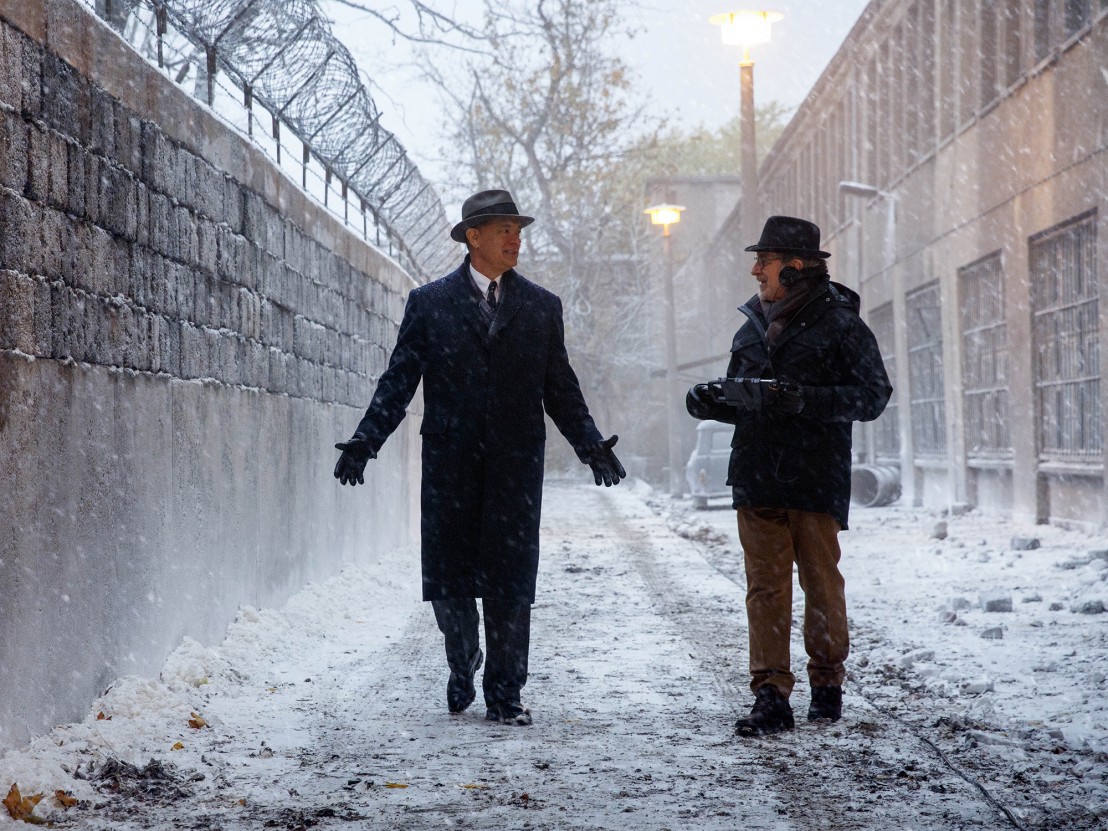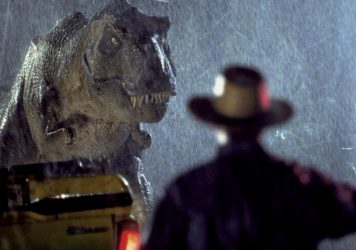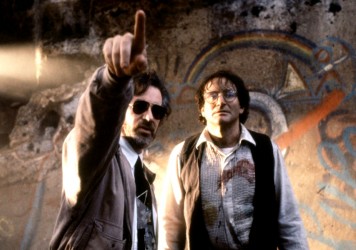
It may seem a mite weasley to open a feature like this with an apology, but we must do just that. Here is everything Steven Spielberg rewatched and ranked for your amusement. However, despite our best sleuthing efforts (and the fact that iTunes US wouldn’t accept our UK credit card), we were unable to watch Marcus Welby MD: The Daredevil Gesture, an episode of a TV serial directed by Spielberg in 1970, and TV episodes of The Psychiatrist and Owen Marshall: Counsellor At Law. So here – bar some small-screen flotsam – is everything…
Or, if you’re feeling eager, skip directly to the top 20 here.
One of the hopes of this exercise in bulk-viewing and ranking Spielberg’s work, was that we’d be able to reassess films we’d perhaps overlooked or underrated the first time around. It’d be a pleasure to report that The Terminal was one such title, but as you’ve likely assumed from its positioning way down here at the bottom of this list, it’s as witless a fiasco now as it was back in 2004. On paper, it certainly fits the criteria for thematic auteurist contention; in reality, it’s a straight-up vanity project for its leading man, with zero formal or political engagement from its helmer. Bizarre (and creepy) sub-plots abound as Hanks grapples with his accent while Catherine Zeta Jones grapples with Napoleon. It finally amounts to nothing but a missed opportunity for Spielberg to ask real-world questions of contemporary America. Matt Thrift
A two-minute spoof made for the White House Correspondents’ Association dinner the year after both Obama’s reelection and Spielberg’s release of Lincoln, the joke is that we see the real Obama pretending to be Daniel Day-Lewis playing Obama. If the idea is a superficially amusing nod to Day-Lewis’s chameleon skill and Obama’s willingness to self-mock, the filmmaking is anonymous and the subtext is disturbing: Obama – rehearsing “Hello Ohio!” and “I love you back!” in the mirror – seems complacent about the idea that politics is all performance, while Spielberg shrugs at being an insider. A smug and throwaway establishment curio. Ian Mantgani
Spielberg whips open iMovie to cobble together a series of photographic slow-zooms and talking head interviews for a seven minute tribute to the military. Made for the 2008 Democratic convention, unsurprisingly, it’s jingo all the way. Tom Hanks narrates, telling us how today’s soldiers, “walk in the footsteps of those who came before,” choosing to answer the eponymous “timeless call” of their country. He wanders on-screen at the end, not wearing a tie – with two buttons undone, in fact – an off-message detail seemingly at odds with the portentous gravitas of the ’Berg’s gentle zoom, the twinkling ceremonial trumpets of John Williams’ kill-me-now score, and his stately descent of two wholly unnecessary steps. “Relax,” his tie-less attire suggests, “I’m Tom Hanks, and I come in the name of Freedom.” MT
After the horrifying helicopter crash on the set of John Landis’s segment of Twilight Zone: The Movie (actor Vic Morrow and two child extras were killed), Spielberg apparently lost interest in directing his chapter and according to colleagues was going through the motions. Scatman Crothers plays Mr Bloom, a Santa for the elderly, smirking simpering benevolence at a retirement home and magicking the residents into infants for a night to teach them to be young at heart. Bewilderingly straightforward, bathed in white light, drowned in music, it’s an inert recitation of self-parodying gloopiness, unconvincingly trying to overcompensate for its director’s rudderless disconnection. IM
Spielberg’s first professional short, about a naïve boy freewheeling with a hippie chick on the California highway, ends by revealing its protagonist’s guitar case to be empty of musical instruments. You can choose to view that as Spielberg’s poignant nod to being unsynchronised with his generation or as an admission of hollowness for what amounts to a modish, patronising Meet Cute of free-love hitchhiking. With a twanging acoustic soundtrack and gooning dialogue-free gesture, Amblin’ goes for a folk-rock update of Chaplinesque simplicity but plays like a callow, mawkish ruse. Spielberg’s first collaboration with cinematographer Allen Daviau, the good part is its embryonic fascination with voyeuristic establishing shots and golden purple twilight hues. IM
For better or worse, Spielberg has always been a fan of business: those small comedic or observational grace notes slipped in to add texture to a given sequence. 1941 – his tone-deaf folie de grandeur – is all about the business. In fact, it’s only about the business. It’s a proto-Crystal Skull gopher writ large across 146 minutes, a Frankensteined amalgam of Mad Magazine zaniness and targetless satire; a rare instance of Spielberg’s grasp on his material gone AWOL. From the film’s Jaws-riffing, auto-fellating intro to Slim Pickens’ painful Strangelove-schtick, one might notice the tumbleweed were it not for the bludgeoning effect of the legendary (and all-too-visible) budgetary combustions. The dancehall and Dumbo scenes work, and the Hollywood dogfights have some flair, but the leaden thud of almost every gag makes for an arduous viewing experience. MT
Someone in an office situated in a dim corner of a Hollywood lot had a slip of paper with Shia LaBeouf’s mugshot and a red pen circling it, lifting him out from the matinee idol masses and selecting him for the fast track to stardom. Alas, the films he starred in were all stratospherically naff, though Stevie’s silly franchise cash-in, Indiana Jones and the Kingdom of the Crystal Skull, at least had a sense of humour to it, which is not a claim you can make for the Transformers movies. This time out, everyone’s a little older, everything looks a little faker, and no-one really looks that happy to be there, with the eponymous “skull” revealed to be the key to unlock an… ancient flying saucer. It did, on the other hand, spur on a craze of people running into nuclear test sites and hiding in fridges, which can definitely* protect you from the blast. David Jenkins
Spielberg’s much-hyped return to network television with Amazing Stories proved a massive flop. Conceived along similar lines to Alfred Hitchcock Presents – 30 minute episodes helmed by different filmmakers – he directed two himself, one a hauntingly evocative Spielbergian miniature, the other a bloated, whimsical mess. His sophomore effort The Mission, expanded to fill an hour slot after the first cut ran over, sees the director flexing his most saccharine tendencies. A gunner becomes trapped beneath a World War Two bomber in flight. With the landing gear broken, he uses his sketchbook to draw animated wheels onto the plane, which magically appear to facilitate a landing. Spielberg demonstrates his set-piece chops in the final few minutes, but the preceding filler and teeth-grinding tone (not helped by a gratingly earnest Kevin Costner) mean it’s too little, too late. MT
Spielberg’s second shot at a segment of Rod Serling’s anthology TV show Night Gallery toned down the experimentation of his earlier Eyes, relying more on conceptual pathos than the closing in of visual schema. Godfrey Cambridge plays a flop nightclub comic who wishes to a genie that he could make people laugh, inevitably resulting in the twist that nobody can ever take him seriously for erupting in hysterics. Spielberg is already dollying in for reaction shots but this is generally technically muted, and despite Cambridge’s Faustian pact, his fate seems less like a bitter irony of poetic justice than a disproportionately cruel chapter of airtime. NBC executives called for Spielberg to be fired. IM
Spielberg’s first professional directing gig was this centrepiece of the Night Gallery pilot. Working with a major star in Joan Crawford, the director’s precocity is immediately apparent, even as the material amounts to sub-Twilight Zone hokum. Crawford plays a blind dowager-cum-Fifth-Avenue-Bond-villain, awaiting a morally dubious operation that will give her sight back for just twelve hours. While she’s having a blast with the dialogue (“No one has ever done me justice, beginning with God!”), Spielberg practices his master-shot blocking, leading to an abstractly choreographed finale that puts the episode’s book-ending segments to shame. MT
After two feature-length pilots had started to develop the formula and character for Peter Falk’s shaggy sleuth, Spielberg came in to direct the first episode of the series proper. Involving the lesser man in a duo of crime writers murdering his partner and foolishly thinking he can leave a trail of false alibis to prove he wasn’t there, this entry is hampered by having one of the show’s stupidest villains with the flimsiest of schemes. Spielberg propels the episode with some binary cutting, but also sneaks in shadows, voyeurism and haunting sound design for the crime scenes and gives Falk space to further work on his persona – both the director and this show were yet to discover their magic, but were moving along professionally. IM
One of Spielberg’s more interesting early TV jobs, LA 2017 was the director’s first step into science fiction, a feature length episode of the Gene Barry-starring series, The Name of the Game. More stylistically muscular than his previous small screen assignments (a cracking third act car chase prefigures Duel in its construction), it’s essentially a straight-faced, Orwellian Sleeper. A publishing tycoon has travelled from 1971 through a nondescript time warp, awakening to an ecological catastrophe that has driven a now corporate-run society underground. It’s Dystopia 101 for the most part, but Spielberg has fun with the details, not least the technological devices of his surveillance state. Calling it a sketch for Minority Report would be generous, but one can already sense the director’s engagement with world-building minutiae. MT
Having exploded into public and critical consciousness with his 1971 TV movie Duel, it was clear that Spielberg had outgrown the medium in which he’d cut his teeth. His final TV job – made to fulfil a contractual obligation – Savage stars Martin Landau as an Ed Morrow-style investigative journalist who becomes embroiled in a case of political blackmail. If the plotting belies its genesis as a procedural pilot, Spielberg goes hell for leather with his stylistic arsenal. Complex master-shots, bird’s eye perspectives and frenetically staged reverse-dollies show no sign of a phoned-in performance, which is all such disposable material really deserved. MT
Robert Bresson’s Au Hassard Balthazar as retooled for the Great British Bake-Off set, Spielberg’s solid adaptation of Michael Morpurgo’s 1982 children’s novel, War Horse, is one of his late works which succumbs too obviously and too quickly to cheap sentimentalism. An account of World War One as directly experienced by a trusty steed, the film is front-loaded with tall tales of helpful strangers caught in the cross-fire of conflict, but little is stated beyond the obvious, “war is awful for everyone, even horses.” And yet, this is clearly directed by someone who knows exactly what he’s doing, and the emotional beats are played to teary-eyed perfection. As whimsical as it sometimes it, there’s a cumulative effect to the episodic story that creeps up on you in its latter stages. But before its clunker of an ending. DJ
There was no way that this sequel to the world-beating Jurassic Park was going to get an easy ride. The leap the original took from zero to dinosaurs was gigantic, and what we have here is a pitiful lunge from dinosaurs on an island to dinosaurs on the mainland – for a little while. The plot rehashes the tired old Alien formula with shady corporate entity InGen looking to cut its losses by sneaking a still-at-large T-Rex back to San Diego for an attraction at the zoo there. It proves, as viewers might have suspected, to be a bonehead play. Seeing the same dinos cause the same distress again really has little shock value second time out, but luckily we have the strange sight of a young Vince Vaughn playing it straight as one of the male leads. Spielberg bowed out of things before the godawful third part was birthed, though maybe regrets leaving directorial duties to the recent fourth film to whippersnapper Colin Trevorrow, as it has made more hard bunce than his revolutionary original. DJ
Somewhere between a proto-Lincoln and a burden of self-conscious historical responsibility following Schindler’s List’s divine inspiration, Spielberg attempted to enter the horrors of slavery through this property-rights courtroom drama about the aftermath of a bloody rebellion at sea. Caught between dispelling the myth of America as a place of sanctuary and rote sentimentality about the promise of a more perfect union, Amistad comes alive in its terrifying, lightning-strobe flashbacks to the slave ship and Djimon Honsou’s portrayal of a Mende captive, but clunks uncertainly through its examination of legal debate – blinded by dutiful obligation to narrative, Spielberg sidesteps making the tragic chronicle of the slave experience he really wants to engage with. Anthony Hopkins goes for shaggy grit as John Quincy Adams, but his entire performance is drowned out by inappropriately reverent trumpets. IM
Retrospectively viewing Saving Private Ryan, with the advantage of the hindsight granted by Spielberg’s post-millennial run of challenging, morally complex pictures, is a depressing experience. It’s an influential film – chiefly remembered for its opening D-Day beach attack and as the second to grant the filmmaker an Oscar for direction – setting a tedious standard for purported verisimilitude in the depiction of action. The epic sweep of those opening thirty minutes remain as impressively choreographed as ever, but two hours later – upon realisation that the film has so little to say beyond the most reductively jingoistic platitudes – even its formal qualities (detached from any kind of meaning) take on a glibness that matches the film’s confused and uncomfortable dramatic ironies. Watch it after Terrence Malick’s The Thin Red Line, released the same year, and its hollowness becomes even more glaringly apparent. MT
Spielberg’s official debut feature for movie theatres is a charming if rambling and unlikely homage to late-’60s American New Wave classics like Arthur Penn’s Bonnie and Clyde, following as it does two tearaways whose minor roadside infraction turns them into law-baiting celebrities. With Goldie Hawn and William Atherton as lovable rubes Lou Jean and Clovis Poplin, the former convinces the latter to dash from his low security prison with just 40 days before his sentence expires in a bid to save their child from being sent up for adoption before they can claim him. It doesn’t all hang together, and it’s often a little shrill and directionless, yet it’s remains a remarkable piece of craftsmanship. If nothing else, The Sugarland Express goes some way to suggesting that all directors should earn their spurs by filming and perfecting car chases before they ever get allowed to meddle with the serious stuff. DJ
For anyone under the age of 35, odds are that Hook was a staple of childhood viewing. In retrospect, it’s not very good – at least in any objective sense – but it remains one of Spielberg’s most fascinating films, a key text of naked psychological auteurism. The transposition of JM Barrie’s story into a study of male anxiety, absent fathers and parental failure seems the perfect fit for Spielberg, a filmmaker pre-disposed to Peter Pan (and Peter Pan syndrome) narratives. Yet making explicit what was subtextually buried in say, Empire of the Sun, only serves to bring out the director’s worst tendencies, leading to a viewing experience akin to watching a grown man visibly regress and weep for two hours at the end of a breakthrough psych session. It’s a compulsively readable folly, but evidence of the fine line between an omelette and scrambled eggs. MT
With the addition of Sean Connery as Indy’s father, a duplicitous Nazi bombshell as the love interest and set-pieces including a Venice speedboat chase, the third (and unfortunately not final) adventure of grave-robbing à la Dr Jones played more like a crack at 007. The most full-blooded moments go back to subterranean slithering and supernatural sorcery, but this is a more rhythmically relaxed, tastefully handsomer entry than its predecessors, the trade-off being the series’ sense of wonder and magic energy. A fun action film made by a professional parent, rather than the whizz-bang rollick of a crazed, overgrown child. IM
Timing is everything in Spielberg’s star-packed dramatisation of The Washington Post’s historic reporting of the Pentagon Papers leak. Released one year into Donald Trump’s presidency, the film staunchly advocates the constitutional right of freedom of speech in the US during a period of heightened tension between the government and the press. As state of the nation addresses go, however, there’s little here to really get the blood pumping, save for a few genuinely thrilling shots of industrial-scale printing presses whirring away as the early-hours deadline looms. The Post’s message may seem especially worthy given the current political climate, but it remains one of the director’s less newsworthy endeavours. Adam Woodward
Now head to Part Two, in which we reveal the top 20…
Published 10 Nov 2015

Steven Spielberg’s beloved 1993 movie is about so much more than dinosaurs.

Did E.T. really cause the 1983 Video Game Crash? Michael Leader goes in search of a pop culture myth.

By James Clarke
Does the director’s take on JM Barrie’s classic tale of arrested development deserve its reputation?